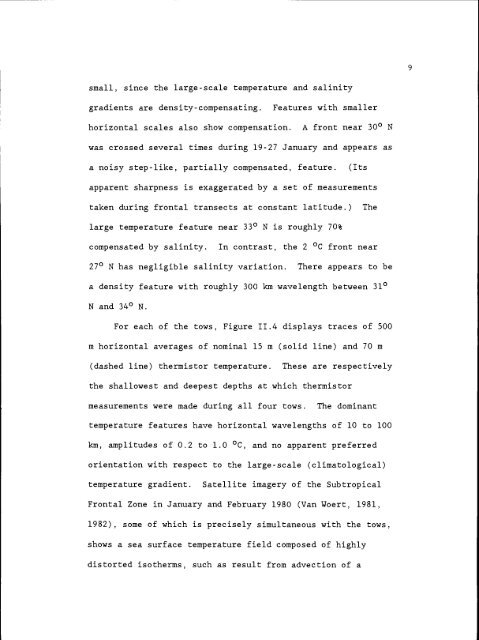Observations and Modelling of Fronts and Frontogenesis
Observations and Modelling of Fronts and Frontogenesis
Observations and Modelling of Fronts and Frontogenesis
You also want an ePaper? Increase the reach of your titles
YUMPU automatically turns print PDFs into web optimized ePapers that Google loves.
small, since the large-scale temperature <strong>and</strong> salinity<br />
gradients are density-compensating. Features with smaller<br />
horizontal scales also show compensation. A front near 300 N<br />
was crossed several times during 19-27 January <strong>and</strong> appears as<br />
a noisy step-like, partially compensated, feature. (Its<br />
apparent sharpness is exaggerated by a set <strong>of</strong> measurements<br />
taken during frontal transects at constant latitude.) The<br />
large temperature feature near 330 N is roughly 70%<br />
compensated by salinity. In contrast, the 2 °C front near<br />
27° N has negligible salinity variation. There appears to be<br />
a density feature with roughly 300 km wavelength between 310<br />
N <strong>and</strong> 34° N.<br />
For each <strong>of</strong> the tows, Figure 11.4 displays traces <strong>of</strong> 500<br />
m horizontal averages <strong>of</strong> nominal 15 m (solid line) <strong>and</strong> 70 m<br />
(dashed line) thermistor temperature. These are respectively<br />
the shallowest <strong>and</strong> deepest depths at which thermistor<br />
measurements were made during all four tows. The dominant<br />
temperature features have horizontal wavelengths <strong>of</strong> 10 to 100<br />
km, amplitudes <strong>of</strong> 0.2 to 1.0 °C, <strong>and</strong> no apparent preferred<br />
orientation with respect to the large-scale (climatological)<br />
temperature gradient. Satellite imagery <strong>of</strong> the Subtropical<br />
Frontal Zone in January <strong>and</strong> February 1980 (Van Woert, 1981,<br />
1982), some <strong>of</strong> which is precisely simultaneous with the tows,<br />
shows a sea surface temperature field composed <strong>of</strong> highly<br />
distorted isotherms, such as result from advection <strong>of</strong> a















